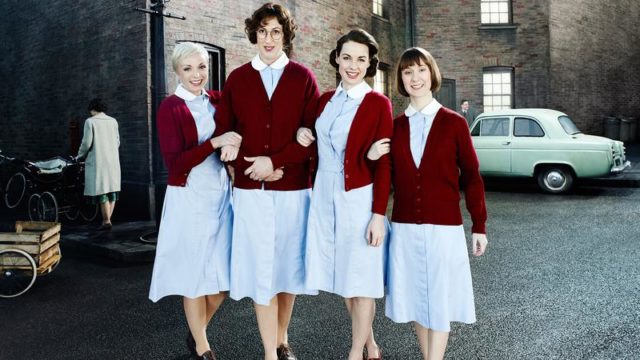
There is much to love about PBS’s Call the Midwife. The characters are fantastic, the scripts are brilliant, and the show takes on what life really was like for women in poor communities giving birth. The show makes viewers laugh often and cry a lot because it treats a serious subject matter in such a tender, humorous way. Here are five things you might not have known about Call the Midwife.
5. Chummy Look Familiar?
The sturdily built, posh, awkward character of Chummy may look familiar to those who watch BBC Sitcoms. She’s none other than Miranda Hart of the show Miranda fame. Although she is playing a different character, Camilla “Chummy” Browne has all of Miranda’s adorable appeal. Who doesn’t just love Miranda Hart? She signed on for the project ahead of time, saying that if the book was adapted, she was happy to take part in Call the Midwife.
4. Based On Fact
Call the Midwife is based on the book by Jennifer Worth, detailing her time as a public health midwife in East End London in the 1950s. As for the thalidomide storyline that shocked many viewers, yes, the drug was given to many expectant mothers, and yes the birth defects were horribly tragic, and yes, many of those poor babies were left to die and the mothers were told that they gave birth to a stillborn child. The fact that the medical community prescribed the drug freely and even ignored the correlation with birth defects for some time is particularly chilling.
3. The Real “Jenny Lee”
It just so happens that Jennifer Worth’s maiden name was Lee. She died of cancer in 2011 before she could see what a smash hit the series made from her book had become. Like her fictional counterpart, Jenny had left Nonnatus House to work with terminally ill patients. Ms. Worth wrote several books about her experiences as a public health nurse serving the poor and those on the fringes of society at the time, like the mentally ill.
2. The Comical Enema
When the girls tell Chummy to roll over for her enema, “high, hot and a hell of a lot!” they were dead serious. They made a joke of it with their fellow nurse, who was about to go through some pretty awful pain to have that baby. That was how women were prepped for childbirth in those days. Just seeing what women went through to give birth more than half a century ago makes one wonder where all of those baby boomer babies came from. These ladies were brave! Fans applauded the episode when anesthetic as finally introduced. Still, the 1950s brought in a golden age of health care, that included pre-natal care for the mother, which reduced infant and mother mortality rates, hot enemas and all.
1. Storyline Close to Home
No one can forget when Judy Parfitt’s character, Sister Monica Joan, began to struggle with symptoms of dementia, a disease that was a mystery in the post-war era. Judy reached into her life experiences to portray the illness with kindness and dignity, while not shying away from authenticity. This is because she lost her late husband, Tony Steedman from the disease.
 Follow Us
Follow Us





